
In this much-requested follow-up article to our introductory series to Agile Results, I want to show you how to deploy your Agile Results system inside Evernote.
It is assumed you have read both JD Meier’s book Getting Agile Results, and our introductory series, otherwise this guide may not make that much sense. Some of the things may overlap what the introductory series and some things will be a little different – that’s because systems evolve over time with use.
It should also be noted that what is described here does not strictly conform to the Agile Results system as it is originally taught, but because the system itself is so flexible and provides a robust framework, it still works very effectively.
Quick Summary
- What Goes Where.
- The Setup.
- First Run-Through.
- Using the System.
- Customizing the System For You.
1. What Goes Where
Let’s start with a list of the big concepts and ideas in Agile Results. We have:
- The Rule of 3.
- Hot spots, aka areas of life.
- A weekly cycle of vision, outcomes and reflection.
- Daily and weekly outcomes.
- Queues.
- Actions.
- References.
- Schedule.
So which parts of this do we recommend go into Evernote?
- The Rule of 3, in the form of outcomes.
- The weekly cycle.
- Outcomes.
- Actions.
Everything else goes elsewhere:
You task manager will hold your hot spots (areas of life), your queues (lists of things to do) and your actions (before they are copied into Evernote).
Your wiki or database – we recommend DevonThink on Mac – stores all your references.
Your calendar holds your schedule.
The Setup
Setting this up is pretty straightforward.
The first thing you want to do is create some notebooks in Evernote:
- Daily Journal.
- Weekly Journal.
- Monthly Journal.
- Annual Journal.
- Journal Templates.
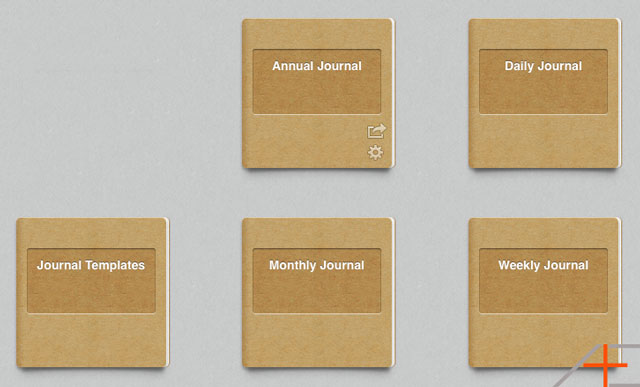
You then want to drag-and-drop them into one notebook stack and call it “Personal Journal” or “Agile Journal” or something similar.
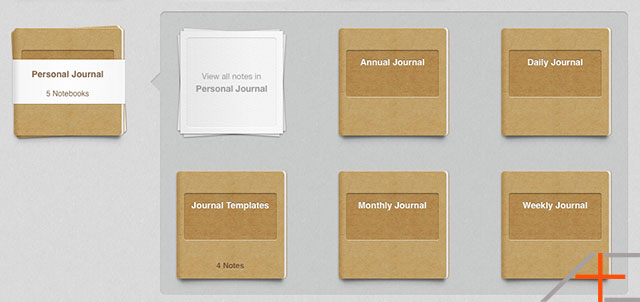
You then want to create your own journal templates as individual notes inside the Journal Templates notebook.
Daily Template
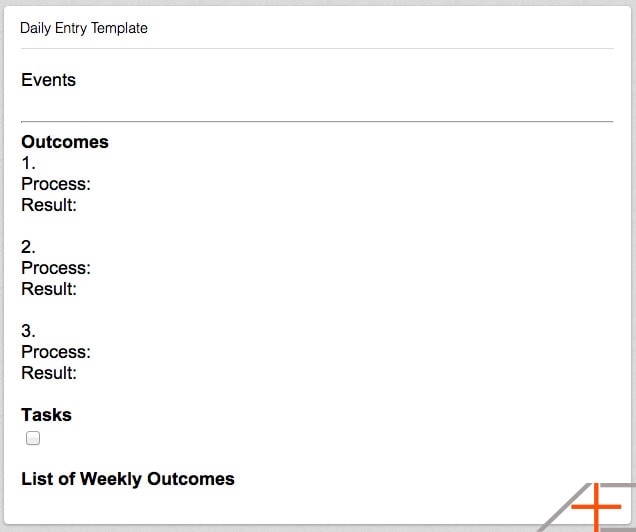
Here’s what the different sections mean:
- Events. This is where you get to describe the events or other thoughts about your day in free-flow writing.
- Horizontal Rule. Provides a nice visual divide.
- Outcomes. List your three outcomes. Each has a title, a process (how it’s done) and a result (what it will look like when it’s done).
- Tasks. List the tasks that form your outcome, as well as other tasks that sit outside of your outcomes. You can and should use Evernote checkboxes for this.
- List of Weekly Outcomes for Reference. This is so you can see the immediate next level up from your daily outcomes. We have found that this helps immensely with keeping track of the bigger picture and longer-term goals.
Weekly Template
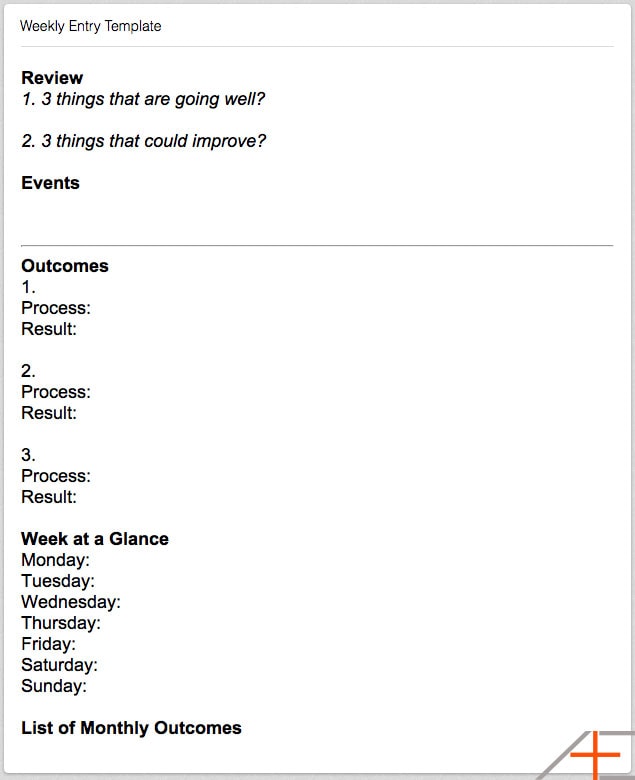
Here’s what each section means:
- Events/Review. This is where you describe your week, and reflect on things at the start and end of the week. It should also include 3 things that are going well that week, and 3 things to improve on.
- Outcomes. List your three outcomes for the week. Give each a title, a process and a result.
- Weekly-at-a-glance. If you like, you can sketch out a rough plan of your week Monday through Sunday, day-by-day. I don’t personally do this but it is part of Agile Results.
- List of Monthly Outcomes for Reference. Again, this will show your outcomes at the next chronological level up and help you focus on the right things.
Monthly Template
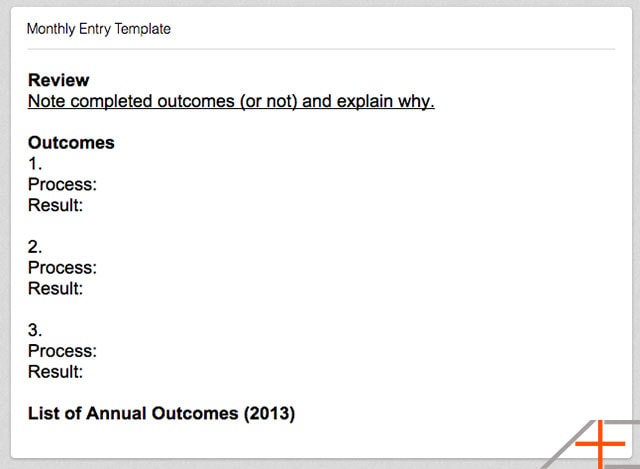
Here’s what each section means:
- Events/Review. This is where you describe your month, and reflect on things at the start and end of the month.
- Outcomes. List your three outcomes for the moth. Give each a title, a process and a result.
- List of Annual Outcomes for Reference. As above, this shows your outcomes for the next level up and helps with directing your monthly outcomes towards them.
Annual Template
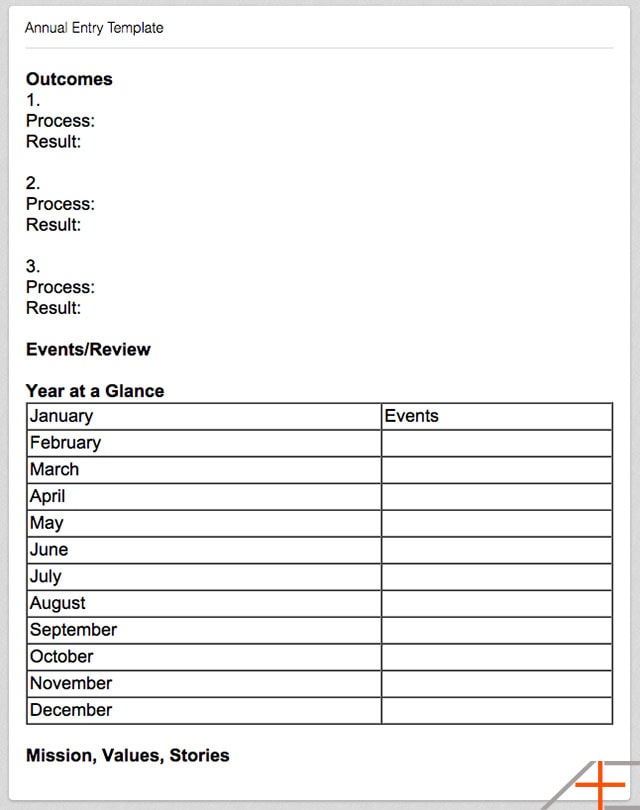
This one is a little different:
- Outcomes. Your 3 outcomes for the year. Include a title, process and result.
- Year-at-a-glance. I personally don’t use this (you’ll see what I do instead later in this guide), but you can map out your year month-by-month if you like.
- Events/Review.
- Section for mission, values, stories. The annual journal entry is a great place to put down our long-term mission, values and stories related to each area of life. This is because what you plan to achieve on a yearly basis, should link to all of those.
First Run-Through
The first time you deploy this system it will be a little unfamiliar. And a little repetitive. Here is how you do it step-by-step.
1. Copy the Annual Template note from the Journal Templates notebook into your Annual Journal and rename it Annual Journal Entry 2013 (or 2014 etc). As such:
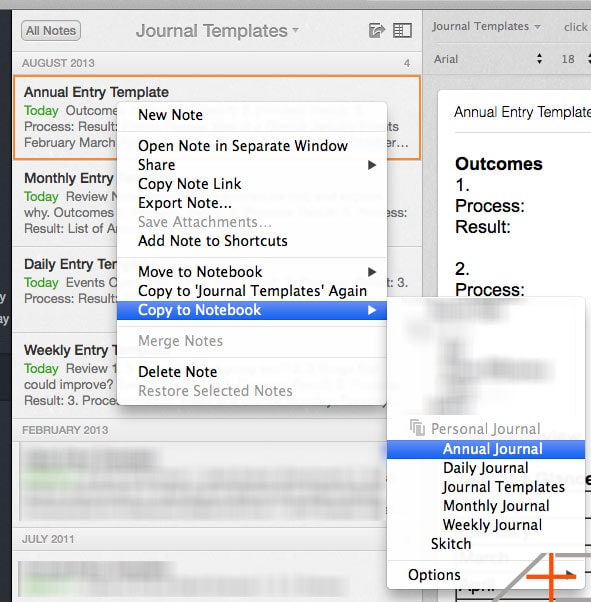
2. Fill it in. Then select all your annual outcomes, and copy them into the Monthly Template note under the List of Annual Outcomes for Reference.
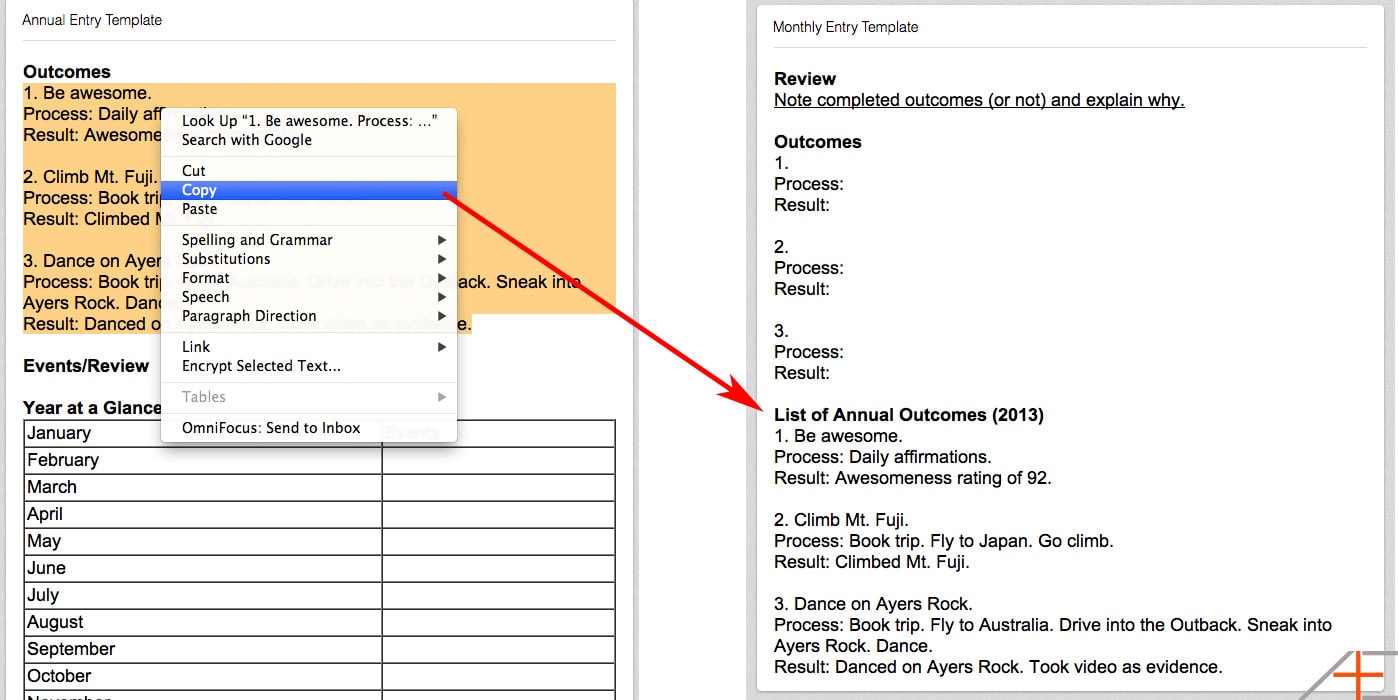
3. Copy the Monthly Template note from the Journal Templates notebook into your Monthly Journal and rename it Monthly Journal Entry 2013 November or the relevant month.
4. Fill it in. Then select all your monthly outcomes, and copy them into the Weekly Template note under the List of Monthly Outcomes for Reference.
5. Copy the Weekly Template note from the Journal Templates notebook into your Weekly Journal and rename it Weekly Journal Entry 2013 Week 48 or the relevant week.
6. Fill it in. Then select all your weekly outcomes, and copy them into the Daily Template note under the List of Weekly Outcomes for Reference.
7. Copy the Daily Template note from the Journal Templates notebook into your Daily Journal and rename it Daily Journal Entry 20131129 or the relevant date.
8. Fill it in.
I hope that from the above you can see the hierarchy of how this system works, and how each chronological level is very closely linked to the level above it.
There are a couple of things to note about what to fill in.
Every outcome must have a title, process and result. I strongly recommend writing an actionable title that is easy to understand right away. If you have any doubts, see this article on setting better outcomes. Every outcome should also have a rough process assigned to it. This could simply be a list of tasks related to the outcome, or it could be an actual description of how you’re going to go about achieving the outcome. Finally, every outcome must also have a defined result, or what it’s going to look like when it’s done. This is so you can very clearly tell exactly when the outcome has been achieved.
Tasks differ from outcomes in that many tasks usually form one outcome. For example, you may have an outcome of “close sales deal” but then have 3 related tasks – 1) call client, 2) email contract, 3) file before close of business. Having a task list at a daily level also lists tasks you have that are related to your daily work responsibilities but not related to your outcomes – this lets you be flexible with what you’re doing without affecting your hierarchy of outcomes too much.
Using the System
Using this Evernote setup is simply a matter of doing a modified version of the above run-through process at the start of every timeframe (or at the end of the previous timeframe).
For example, at the end of the year/start of the new year, you want to:
- Make a copy your annual template and fill it out, making references to any longer-term goals, missions, visions, values or projects you’re aware of.
- Copy the filled out annual outcomes into the monthly template.
At end/start of every month, you want to:
- Review the prior month.
- Make a copy of the monthly template into your Monthly Journal and fill it out.
- Make sure you refer to your outcomes, any work project management systems, your schedule and your task manager (for hotspots, queues of tasks and projects).
- Copy the filled out monthly outcomes into the weekly template.
At the end/start of every week, you want to:
- Review the prior week. List 3 things that went well and 3 things that could improve.
- Make a copy of the weekly template into your Weekly Journal and fill it out.
- Make reference to your monthly outcomes, any project management systems, your schedule and of course your task manager.
- Copy the filled out weekly outcomes into the daily template.
Every day, you want to:
- Wrap up the current day’s journal entry. See what tasks you have left over, see how each outcome went and describe/review your day.
- Plan tomorrow. We recommend doing this the night before. Plan both your outcomes AND your tasks. Refer to your weekly outcomes, your project management systems, your schedule and your task manager.
During the day, you want to refer to your daily journal entry and check off tasks as they are complete and note beside each outcome as it is completed.
Customizing the System For You
The great thing about Agile Results is that it provides a solid framework for customization. It’s strength lies in its outcome hierarchy which let you direct your days, weeks, months and years. On top of that though, you can build and implement custom ideas that you’ve learned here on Asian Efficiency or elsewhere, with relative little effort. Here are some examples that I personally use.
Focus and Maintenance Outcomes
I wrote a premium newsletter earlier this year on the difference between focus and maintenance outcomes. At the weekly and monthly level, I like to split my outcomes into 3 focus outcomes (Agile’s Rule of 3) and 2 maintenance outcomes. I regard focus outcomes at the things I am developing and that will take up most of my time. Maintenance outcomes are things that tick away in the background without me really thinking about it – for example, the hour of reading/learning I do every day, or my workouts 3 times a week, or the pre-planned meals I eat every day.
All this takes is listing in my weekly and monthly journal 2 extra maintenance outcomes.
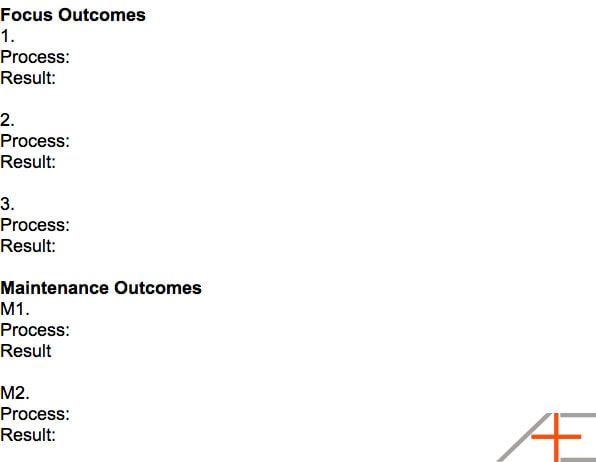
Pain and Pleasure Motivators
I like to make my outcomes really compelling and give them that extra kick of motivation. So, for every outcome at a monthly or annual level, I’ll add in a painful scenario if I don’t hit the outcome and a pleasurable scenario if I do.
This sits right alongside the outcome title, process and result.

Questions
I read a lot of Tony Robbins this year and he says that the questions we ask ourselves help us make new distinctions about what we’re doing.
So, I added in 3 questions to my daily journal entries to ask myself:
- What have I given today?
- What did I learn today?
- How has today added to the quality of my life or how can I use today as an investment in my future?
Quarterly Sprint System
Agile Results has a built-in sprints system where JD Meier recommends picking 1 fun thing every month and running with it to learn about it.
I personally don’t really do this anymore but instead make my sprints longer, and divide up my year by quarters.
So in my annual journal entry I’ll have something that looks like this:
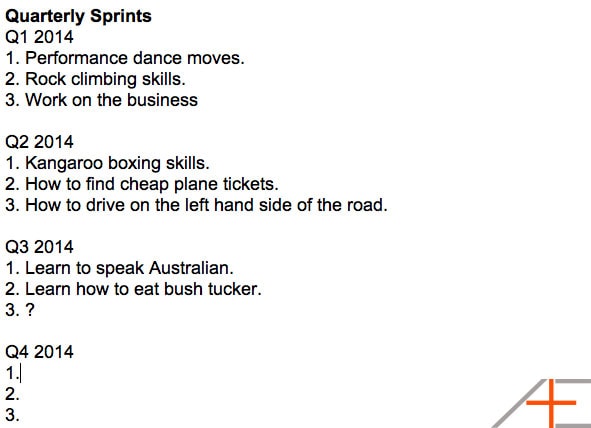
Basically, I break down my year into quarters and list 3 “mini-outcomes” or areas of focus for each quarter. These then feed into my monthly outcomes and become “steps along the way” to hitting my annual outcomes.
Wrap Up
And… that’s it.
Setting up Agile Results in Evernote is very straightforward, just a little repetitive. If anything is unclear, please ask in the comments and I’ll try to answer the best I can.
If you want more articles and tips like these, let us know where we can send them to:

Drag-and-Drop creates “Notebook Stack” instead of “Personal Journal” with sub-journals
Thanks for this guide, incredibly helpful.
Question: What is the difference between action and queue?
I understand it is recommended action and queue both go in a task manager, but what is the difference them? I feel like they are both to do lists. Thanks for your help!
Casey
What is the difference between a title and a result? Is the title like a noun like “Graduation Packet”, the Process “Fill out pages 1-4 and obtain signatures” and the result “Graduation packet submitted to administrative office?”
I got so used to giving things titles (like Email subject lines) that are in the sound of a verb, but this perhaps overlaps with the process/results.
Could you elucidate?
Thanks for this. I’ve been debating where to keep my daily materials, be it Evernote, Omnifocus or DayOne. This has helped me focus on what’s important.
Aaron,
Thanks for the post. nice and clean way to start the new year. You mention you don’t do Year or Month at a glance. What do you do instead?
I’m trying something a little different for 2014 involving quarters and compressing 1 year into 90 days.
Before I just set annual goals and used that as my reference point rather than saying “first week of the month I’ll work on this, second week on that” etc.
No reason not to use Evernote as your reference/wiki. It supports internal links after all, and the web clipper is just great.
Just curious, couldn’t you just create a new group in DevonThink called Agile Journals and have more groups underneath with the relevant journals instead of doing it in Evernote. I mean that way you’re simplifying the system and consolidating tools as you can create RTF notes in DevonThink to enter all your outcomes, tasks, journals and templates. Sorry just trying to figure out the purpose of using Evernote still.
I have tried very similar Agile Result setup like in this post on both programs and found out that Evernote gives me better writing experience and it is more versatile than DTP. I can do it on the go and on my bed with my iPad with EN. With DTP, when you are on the go, it’s not that pleasurable. Plus that Evernote is free and more popular than DTP.
Thanks Wynxz, I totally overlooked cost factor since I own DT and haver EN Premium. Now I’ve struggled with implementing Agile in the past (maybe more so due to overthinking the process). I just can’t figure out how it works in terms of general tasks. (Purchase new Magazine Subscription, Pickup Milk on the way home, Rake the leaves) none of these have much to do with my outcomes for the day, week, month or year but I still have to do them just figuring out where to put them when they come to mind and where they go when you need to do them? Would you place then in EN or would they just go straight into your Task List App (OF or Things)? Also let’s say reoccurring bills can go in your calendar as an all day event when they are due, though if you overlook it you’ll be paying that bill late. Don’t know just some things I struggled with and would like to hear some suggestions to try and implement this system. Maybe more screen shots of examples of the system in use especially on the 4 part series would also help.
@Dan
You can set up a new notebook called Queues/Projects as your to-do manager but I would not recommend that.
Aaron has clarified this issue already:
“Everything else goes elsewhere:
You task manager will hold your hot spots (areas of life), you queues (lists of things to do) and your actions (before they are copied into Evernote).
Your wiki or database – we recommend DevonThink on Mac – stores all your references.
Your calendar holds your schedule.”
For bills, you can use personal finance app like iBank or Money Wiz to manage ur recurring bills. (But I do that with OF).
Here is the sample set up in OF:
https://www.evernote.com/shard/s62/sh/9d45add2-edfd-4a6b-8c78-725697947eb3/c9d99aa30585471a57757a873ee42b45
I suggest you read the Agile Results book. It really helps a lot!
Cheers.
Yep, pretty much what Wynxz said.
Journal in DevonThinks could work, but Devonthink doesn’t do cloudsync the way that Evernote does. I like being able to update entries on Evernote on my phone, and see it reflected on my desktop and iPad right away.